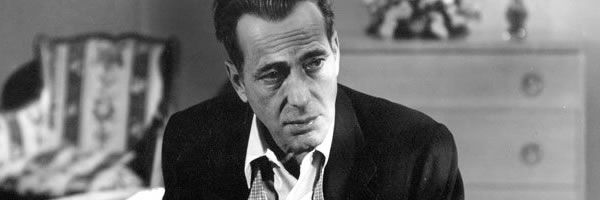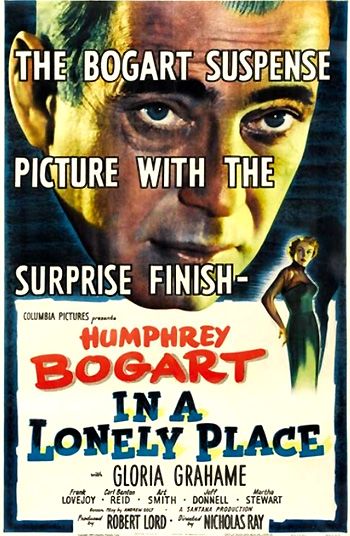What are the characteristics of toxic masculinity? What defines an abuser? While it would be nice if these traits were easily recognizable in broad daylight, they hide behind shades of grey and our society's constant willingness to give bad men the benefit of the doubt. The violence comes in private. It comes with an excuse. One would think that 1950's In a Lonely Place would be painfully retrograde in its depiction of a damaged, violent man, but Nicholas Ray's film noir is immediately captivating and offers no easy answers thanks to Humphrey Bogart's complicated and magnetic lead performance.
The story follows Dixon Steele, a short-tempered and manipulative screenwriter who's been tasked with adapting a novel. He coerces the coat check girl at his local haunt to come over and tell him the story since she's read the book, and after she relates the tale, she heads home. She turns up dead the following morning with Dixon as the prime suspect, but his neighbor, Laurel Gray (Gloria Grahame) vouches for Dixon and begins a romance with the tortured writer. However, the closer Laurel gets to Dixon, the easier she can see that while he may not have been responsible for the girl's death, he's capable of murder.
While the noir genre excels at its depiction of morally complex characters (at least until the Production Code demands some form of retribution or moral balance at the end), In a Lonely Place feels depressingly relevant for how an abuser moves among us. Dixon has fallen out of favor with Hollywood, but not to the point where someone isn't willing to give him a shot at adapting a best-selling novel. He's clearly a bitter, sharp-tongued jerk, but the film drops in little cues to show his abuse as part of his personality rather than something he calculated ahead of time. He knows that when he hurts someone, he has to quickly apologize and make nice because he doesn't want them to leave. Dixon has no problem showing kindness to a washed-up, drunk actor because that person is in no way a threat. He's just charming enough to keep people in his orbit, and manipulative enough to stop them from leaving.
What In a Lonely Place understands and what it's able to render without depicting Dixon as a one-dimensional villain is his need for control. Bogart perfectly taps into Dixon's desperation and his volatility not by making him a sneering villain (and Bogart could be one hell of a bad guy when the role called for it), but instead by showing Dixon as deeply damaged while never asking for forgiveness from the audience. The performance feels so ahead of its time because he's not filling a particular role or giving the audience what they want in terms of redemption or damnation. Dixon eludes both, putting the audience in an uneasy place and at best sympathizing with Laurel, whom we want to protect.
Bogart's best characters have an edge because he knows how to carry an aura of danger with him. There's always something in the back of your mind that this guy might hurt you physically, and then different stories use that to paint Bogart as the hero (Casablanca, Key Largo) or the villain (Black Legion, Treasure of the Sierra Madre), but In a Lonely Place wants you to be uncomfortable with Dixon. It wants you to sympathize with him and keep alive the possibility that he's innocent of murder. But the key distinction the film works to make clear is that while Dixon may not be a murderer in this particular instance, that doesn't absolve him of being a violent individual.
Perhaps Bogart and Dixon were intertwined because the character mirrored elements of Bogart's own personality. Louise Brooks wrote in her essay "Humphrey and Bogart":
"Before inertia set in, he played one fascinatingly complex character, craftily directed by Nicholas Ray, in a film whose title perfectly defined Humphrey's own isolation among people. In a Lonely Place gave him a role that he could play with complexity because the character's pride in his art, his selfishness, his drunkenness, his lack of energy stabbed with lightning strokes of violence, were shared equally by the real Bogart."
While I try to avoid reading into "How much of a stretch is a character for an actor based on his own personality," the complexity of Dixon Steele and the unique angle that Bogart brought to the performance are undeniable. What makes abusers so chilling is that they sometimes recognize their own monstrosity. They can be unpredictable and explosive, and we dismiss or absolve them at our own peril.


